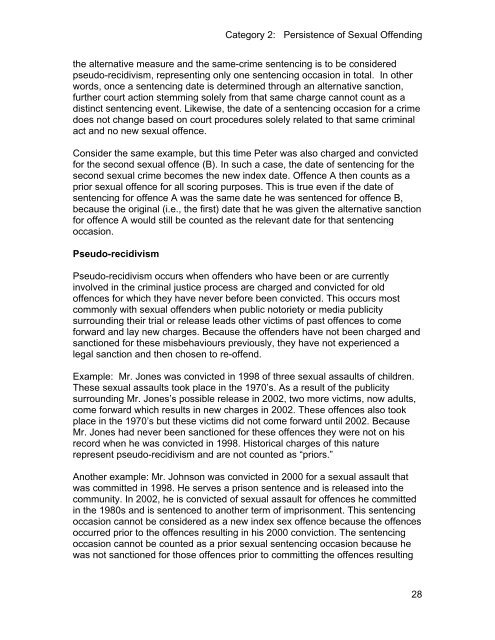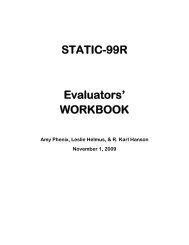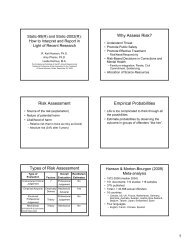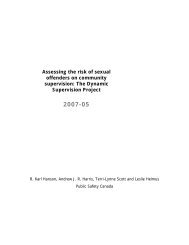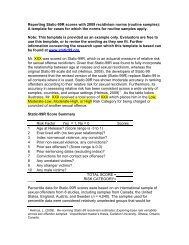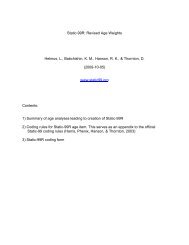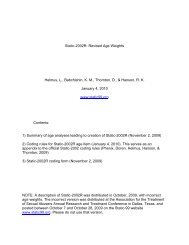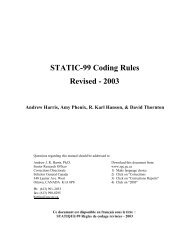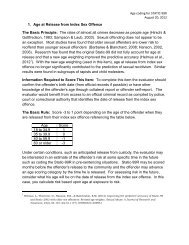Static-2002 coding rules (2009) - Static-99
Static-2002 coding rules (2009) - Static-99
Static-2002 coding rules (2009) - Static-99
You also want an ePaper? Increase the reach of your titles
YUMPU automatically turns print PDFs into web optimized ePapers that Google loves.
Category 2: Persistence of Sexual Offending<br />
the alternative measure and the same-crime sentencing is to be considered<br />
pseudo-recidivism, representing only one sentencing occasion in total. In other<br />
words, once a sentencing date is determined through an alternative sanction,<br />
further court action stemming solely from that same charge cannot count as a<br />
distinct sentencing event. Likewise, the date of a sentencing occasion for a crime<br />
does not change based on court procedures solely related to that same criminal<br />
act and no new sexual offence.<br />
Consider the same example, but this time Peter was also charged and convicted<br />
for the second sexual offence (B). In such a case, the date of sentencing for the<br />
second sexual crime becomes the new index date. Offence A then counts as a<br />
prior sexual offence for all scoring purposes. This is true even if the date of<br />
sentencing for offence A was the same date he was sentenced for offence B,<br />
because the original (i.e., the first) date that he was given the alternative sanction<br />
for offence A would still be counted as the relevant date for that sentencing<br />
occasion.<br />
Pseudo-recidivism<br />
Pseudo-recidivism occurs when offenders who have been or are currently<br />
involved in the criminal justice process are charged and convicted for old<br />
offences for which they have never before been convicted. This occurs most<br />
commonly with sexual offenders when public notoriety or media publicity<br />
surrounding their trial or release leads other victims of past offences to come<br />
forward and lay new charges. Because the offenders have not been charged and<br />
sanctioned for these misbehaviours previously, they have not experienced a<br />
legal sanction and then chosen to re-offend.<br />
Example: Mr. Jones was convicted in 1<strong>99</strong>8 of three sexual assaults of children.<br />
These sexual assaults took place in the 1970’s. As a result of the publicity<br />
surrounding Mr. Jones’s possible release in <strong>2002</strong>, two more victims, now adults,<br />
come forward which results in new charges in <strong>2002</strong>. These offences also took<br />
place in the 1970’s but these victims did not come forward until <strong>2002</strong>. Because<br />
Mr. Jones had never been sanctioned for these offences they were not on his<br />
record when he was convicted in 1<strong>99</strong>8. Historical charges of this nature<br />
represent pseudo-recidivism and are not counted as “priors.”<br />
Another example: Mr. Johnson was convicted in 2000 for a sexual assault that<br />
was committed in 1<strong>99</strong>8. He serves a prison sentence and is released into the<br />
community. In <strong>2002</strong>, he is convicted of sexual assault for offences he committed<br />
in the 1980s and is sentenced to another term of imprisonment. This sentencing<br />
occasion cannot be considered as a new index sex offence because the offences<br />
occurred prior to the offences resulting in his 2000 conviction. The sentencing<br />
occasion cannot be counted as a prior sexual sentencing occasion because he<br />
was not sanctioned for those offences prior to committing the offences resulting<br />
28


